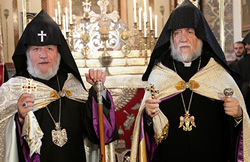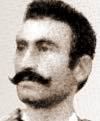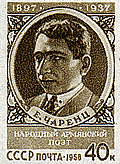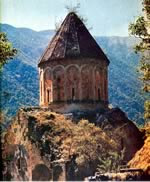Glossary (Bagramian – Dadivank)
Bagramian, Ivan
 Ivan Bagramian
Ivan Bagramian
(1897-1982) also: Hovannes Baghramyan, Prominent Soviet Commander, Marshal of USSR. One of the leading officers during the defence of Kiev (1941), he was then made commander of the 16th army in 1942. He received the order of Suvorov, in 1942, and the medal of the Hero of the Soviet Union twice, in 1944 and 1977.
Bagratuni
(Bagratids) Dynasty of Armenian princes and kings who ruled in Armenia from 885 to 1075. Another brunch of Bagratuni dynasty ruled in Georgia, and later went to Russian nobility under the name of Bagrationi.
Basil I
Emperor of Byzantine Empire (867-886) of the Armenian origin, founder of Macedonian dynasty. He formulated the Greek legal code (Basilica). Until 1025, the Byzantine Emperors were at least part Armenian.
Bitlis
(Baghesh) City in Anatolia in the Western Armenia (present-day Turkey), southeast of the Van Lake.
Catholicos
 Karekin II, Catholicos of All Armenians, and Aram I, Catholicos of the Holy See of Cilicia.
Karekin II, Catholicos of All Armenians, and Aram I, Catholicos of the Holy See of Cilicia.
(Patriarch) Supreme Head of the Armenian Church. The Armenian Catholicoi are elected for life. The traditional seat of Catholicos of All Armenians is in Echmiadzin, near Yerevan. At the same time, the western Armenians kept the tradition of electing a Catholicos of the Great House of Cilicia in the city of Sis. After the Armenian Genocide in Turkey, the Cilician See was moved from Sis to Antilias, Lebanon.
Chavush, Gevork
 Gevork Chavush
Gevork Chavush
(1870-1907) Legendary fedayi famous for his courage and valor in the beginning of the 20th century. He led the Armenian uprising against the Turks in Sassun province from 1904 to 1907, when he was killed in a battle.
Charents, Eghishe
 A 1958 Soviet stamp honoring Charents after his rehabilitation.
A 1958 Soviet stamp honoring Charents after his rehabilitation.
(1897-1937) Eghishe Soghomonian, Armenian poet, prose writer and translator. He was jailed in 1936 during the Stalin purges and then died in prison in 1937.
Cilicia
District of Southern Anatolia (Lesser Armenia), extending along the Mediterranean coast, from the Taurus to the Amanos mountains. In different times, Cilicia was part of Armenia, Roman Empire and Byzantine Empire. In the 11th-14th centuries, the region became center of the Armenian principality and then Kingdom known as the Cilician Armenian Kingdom.
Constantine I
Armenian Prince and ruler of Cilicia (1095-1100), son of Ruben I. He united Armenian forces in Cilicia and concluded alliance with the leaders of the First Crusade to resist the Moslem invasions.
Constantine IV
King of Cilician Armenia (1345-1363). His two consecutive predecessors, Constantine III and Guy were assassinated as a result of plots organized by the discontented lords. To avert the decay of his Kingdom, Constantine IV made alliances with the King of Cyprus and the Grand Master of the Order of St. John. He routed the Mamelukes in a battle near Alexandretta.
Constantine of Erznka
Poet in the late 13th -early 14th centuries, native of Erznka city in Higher Armenia. His love lyrics marked the moving from traditional ecclesiastical poetry toward a freer language.
Dadivank
 Dadivank monastery
Dadivank monastery
(Khutavank, Monastery on the Hill). Located in the Khachen principality in Artsakh (present-day west of the NKR, Kelbajar region), Dadivank is an outstanding monument of the medieval Armenian architecture. Tradition states that Dadi, one of the 70 disciples sent to Armenia by Thaddeus, Apostle of Jesus Christ, suffered martyrdom in Artsakh. In 1214, Dadivank (Monastery of Dadi) was built in the ancient place of his burial.







